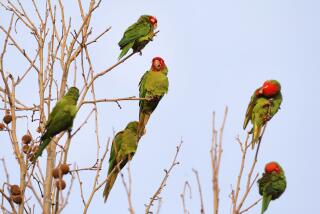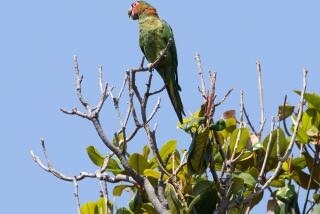Couple Like Birds--but This Is Really Ridiculous
Michael and Wendy Glover are self-styled bird lovers: they own two parrots, three cockateels and a dozen chickens.
But nothing in the Sylmar couple’s relatively tame avian experience prepared them for the Hitchcockian nightmare they endured Thursday night--an invasion of 2,000 birds through their chimney.
About 10:30 p.m., Michael Glover found three sparrow-size birds flapping about in the kitchen and laundry room. His wife then decided to check the rest of the house, opening the door to a hallway leading to the den.
“I turned on the light and there were a thousand birds and they all started flying,” she said. “They were just caked on the walls. . . . You couldn’t see the walls. You couldn’t see anything except birds. . . . All I could think was to just get out of there. It was terrible.”
Migrating Swifts
A massive flock of migrating birds believed to be Vaux’s swifts, a close relative of chimney swifts, had swooped down the Glovers’ chimney and emerged through the fireplace to roost in the den and a bedroom.
It took three city animal control officials four hours to remove the black-and-gray birds . . . one at a time. They estimated the number at 2,000.
“Every year we get reports of flocks of Vaux’s swifts descending into people’s chimneys,” said Kimball Garrett, ornithology collection manager for the Los Angeles County Museum of Natural History. “All they’re doing is roosting for night, driven down by the cool or cloudy weather.”
But, he added, “That’s about the largest number I’ve ever heard of.”
Said Bob Pena, senior animal control officer for the Los Angeles Animal Regulation Department: “This is probably a once-in-a-lifetime situation that we came across.”
Roost in Hollow Trees
Garrett said the birds migrate to forested areas of Northern California, western Canada and southwestern Alaska after wintering in Mexico and Central America. Normally, he said, they roost and build their fragile nests in hollow trees.
But when traveling through urban landscapes, they find chimneys a civilized substitute, he said.
At first, the city workers simply carried the birds outside the house and set them loose. Some just flew away, but others flew back into the house through the chimney and a sliding glass door to the den, Pena said.
Eventually, the city workers decided to put the birds in cardboard boxes--and, when all of the available ones were filled, rubber trash cans--and cart them away. About 600 of the birds were removed that way and released later elsewhere in Sylmar, he said.
Some Still Housebound
Workers finished the job at 3:30 a.m., although a few of the uninvited visitors eluded them. Perhaps a half dozen birds remained housebound, though hardly housebroken, on Friday.
“(The resettled birds) appear to be in good health,” Pena said.
That’s more than can be said for the Glovers’ den and extra bedroom.
Wendy Glover said she fears that her carpet, couches and walls may never be the same.
More to Read
Sign up for Essential California
The most important California stories and recommendations in your inbox every morning.
You may occasionally receive promotional content from the Los Angeles Times.










